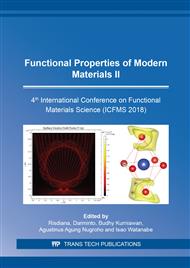[1]
A.K. Khurana, Comprehensive Ophthalmology, fourth ed., New Age International (P) Ltd, India, 2007, pp.247-276.
Google Scholar
[2]
M. Azarmina, M. Soheilian, H. Azarmina, B. Hosseini, Electroretinogram Changes following Silicone Oil Removal., J. Ophthalmic Vis Res. 6(2) (2011) 109-113.
Google Scholar
[3]
B. Lee, M. Litt, G. Buchsbaum, Rheology of the vitreous body. Part I: Viscoelasticity of human vitreous., Biorheology 29(5-6) (1992) 521-533.
DOI: 10.3233/bir-1992-295-612
Google Scholar
[4]
R. Snell, Head and neck, In: Clinical anatomy for medical surgery, Little, Brown and Co., NY, USA, 1995, pp.723-725.
Google Scholar
[5]
K.E. Swindle, N. Ravi, Recent advances in polymeric vitreous substitutes, J. Exp Rev Ophthalmology 2 (2007) 255-265.
DOI: 10.1586/17469899.2.2.255
Google Scholar
[6]
S. Donati, S.M. Caprani, G. Airaghi, R. Vinciguerra, et al, Vitreous Substitutes: The Present and the Future, Review Article, BioMed Research International, (2014).
DOI: 10.1155/2014/351804
Google Scholar
[7]
T.V. Chirilia, S. Tahija, Y. Hong, S. Vijayasekaran, et al, Synthetic polymers as materials for artificial vitreous body: review and recent advances., J. Biometer. Appl. 9(2) (1994) 121-137.
DOI: 10.1177/088532829400900203
Google Scholar
[8]
C. Alovosi, C. Panico, U. Sanctis, C.M. Eandi, Vitreous Substitutes: Old and New Materials in Vitreoretinal Surgery, Review Article, J. Ophthalmology (2017).
DOI: 10.1155/2017/3172138
Google Scholar
[9]
W.J. Foster, Vitreous Substitutes, Expert Rev Ophthalmol. 3(2) (2008) 211-218.
Google Scholar
[10]
J-M. A. Parel, P. Milne, S. Gautier, V. Jallet, F. Villain, Silicone Oils: Physicochemical Properties, In Retina: Fourth Edition, Elsevier Inc. 3(3) (2006) pp.2191-2210.
DOI: 10.1016/b978-0-323-02598-0.50135-x
Google Scholar
[11]
T. Stappler, G. Morphis, C. Irigoyen, H. Heimann, Is there a role for long-term silicone oil tamponade for more than twelve months in vitreoretinal surgery?, Ophthalmologica 226 (Suppl 1) (2011) 36-41.
DOI: 10.1159/000328208
Google Scholar
[12]
N. Soman, R. Banerjee, Artificial vitreous replacements., Biomed Mater Eng. 13(1) (2003) 59-74.
Google Scholar
[13]
Fitrilawati, A.N. Fauza, A. Ardi, R.M. Novianti, N. Syakir, A.S. Kartasasmita, Risdiana, J. Phys.: Conf. Ser. 1080 (2018) 012016.
DOI: 10.1088/1742-6596/1080/1/012016
Google Scholar
[14]
H.S. Nusa, W. Astuti, A.S. Kartasasmita, R. Virgana, N. Syakir, A. Bahtiar, L. Safriani, Risdiana, Materials Science Forum 827 (2015) 99-104.
DOI: 10.4028/www.scientific.net/msf.827.99
Google Scholar
[15]
A. Kartasasmita, W. Kusdiono, R. Virgana, S. Boesorie, In Vivo Emulsification Analysis of 1000 cs and 5000 cs Silicone Oil after Rhegmatogenous Retinal Detachment Vitrectomy Surgery, Open J. Ophthalmology 7 (2017) 231-239.
DOI: 10.4236/ojoph.2017.74031
Google Scholar


